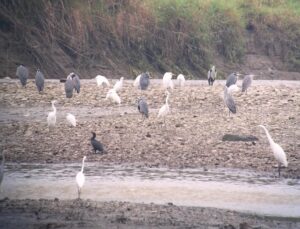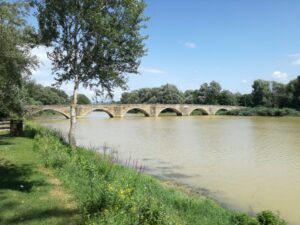Birding with Leonardo And Michelangelo
The whole world is familiar with the paintings and frescoes of the great Italian Renaissance masters, but few know that many of the landscapes and natural elements depicted in these works are real. Michelangelo, Leonardo, Piero della Francesca, and other great artists were so inspired by the environments of Tuscany and other places in Italy that they used them as backdrops or settings in their depictions of sacred figures and illustrious personalities. These landscapes can still be enjoyed today, and they are inhabited by many species of birds at various seasons.
In 2004, researchers identified the landscape painted by Michelangelo Buonarroti in the background of his “Creation of Adam,” in the Sistine Chapel. The profile of the mountain behind Adam, and the rocks on which he reclines, are perfectly recognizable as Monte della Verna, one of the most striking mountains in Casentino Forest National Park. The resemblance between the real landscape and the one in the painting is so close as to suggest that the artist painted his fresco using a drawing made right on the spot.
In 1992, Carlo Starnazzi, a prominent art historian, solved the puzzle of the landscapes seen behind the human subject of da Vinci’s “Mona Lisa”. His study identified a number of places in the province of Arezzo, in eastern Tuscany. When the painting was made, Leonardo had just finished his cartographic work for Cardinal Cesare Borgia. His surveys of the territory between Florence and the Val di Chiana were clearly fresh in the artist’s memory. The arched bridge seen behind the woman in the painting was confidently identified as the Romanesque bridge that still crosses the Arno next to the village of Ponte Buriano. This area is now part of the Ponte Buriano–Penna Nature Reserve, one of the most fascinating protected areas in Tuscany.
Apparently, Leonardo likewise found inspiration in a different landscape, the Balze del Valdarno. The artist certainly passed through this area many times traveling between Florence and Val di Chiana, along the ancient Setteponti Road, and he surely paused to examine the valley and its bizarre prominences; in fact, his papers still preserve a complete description of the Upper Valdarno and the formation of the crags, which are profoundly similar to what is seen in his “Mona Lisa.”
“Marco provided us a full day of birding from the Balze landscapes of Leonardo DaVinci to the mountain villages of the Pratomagno forests. We identified at least 25 to 30 bird species. Probably the most colorful and rewarding species to observe were the colony of Bee Eaters displaying courting behavior” – Happy Customer from TripAdvisor
